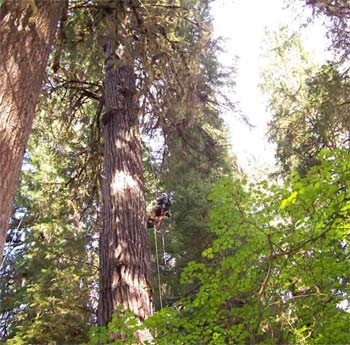Why can't trees be tall?
The famous Douglas fir in the botanical world is more capable than most other plants. But there is still a limit that it cannot overcome, and a new study explains why.
If growing too high, the tree cannot transport water to the highest lying leaves.
Research shows that in the middle of a height equivalent to a 30-35-story building, the Douglas fir could not bring water higher. This prediction also coincides with the tallest fir tree in the world, 99 meters high (the tallest tree in the world is a coniferous tree in California - 115 meters).

Scientist David Woodruff climbs a Douglas fir.Photo: LiveScience.
"The higher in the Douglas fir tree, it is like going through a drought," said Rick Meinzer, a Forestry Service scientist at the Pacific Northwest Research Station.
Evaporation of leaves entails both water and air bubbles. In the Douglas fir, this transport process depends on dead cells, acting as valves and creating most of the wood of the trunk, preventing air bubbles from spreading through the body. By preventing the dispersion of air bubbles through these valves, fir trees also prevent water from being pulled higher.
- America will recreate giant giant trees
- Healing from jackfruit trees
- Strangely, the snakes crawled on the tall trees, staring at the sky
- 'King mushroom' is almost a meter tall in China
- Miraculous plants know
- Alarming the decline of old trees
- The man 'both tall and tall' is unique in medical history
- What do you know about the value of a 50 year old green tree?
- 10 dangerous poisonous species on the tourist road
- Admire the 16 most magnificent ancient trees in the world
- Yellow 'grows' on the tree
- Ancient trees absorb more CO2 than young trees
 'Fine laughs' - Scary and painful torture in ancient times
'Fine laughs' - Scary and painful torture in ancient times The sequence of numbers 142857 of the Egyptian pyramids is known as the strangest number in the world - Why?
The sequence of numbers 142857 of the Egyptian pyramids is known as the strangest number in the world - Why? History of the iron
History of the iron What is alum?
What is alum?